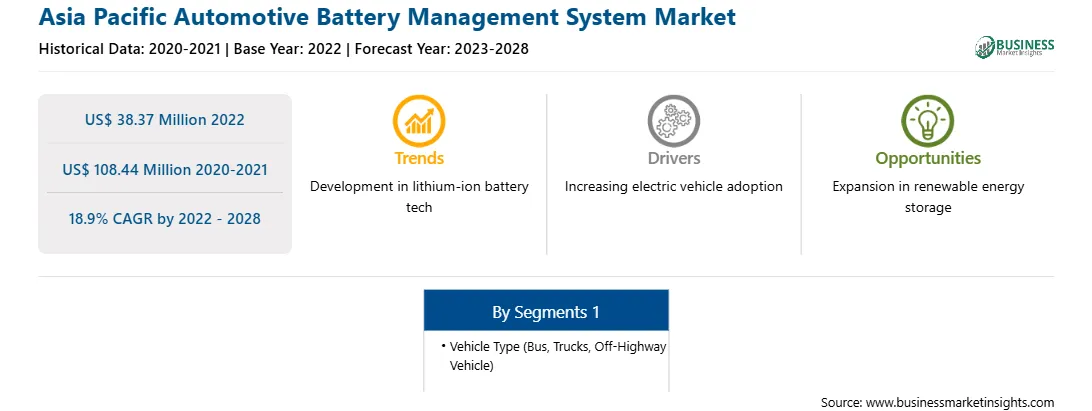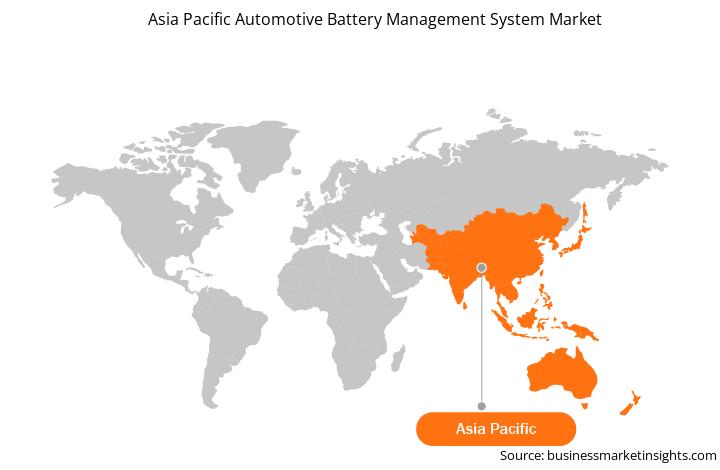Increasing Sales of EVs and Expansion of EV Infrastructure is Driving the Asia Pacific Automotive Battery Management System Market
Transportation, especially road transport involving heavy-duty vehicles such as trucks and buses, is a major contributor to air pollution worldwide. Governments of major countries, including the Japan, and China, are taking initiatives to accelerate the adoption of electric buses and trucks. Further, electric trucks and buses exhibit higher efficiencies than ICE vehicles. Moreover, changes in the costs of batteries and alternative fuels would influence their demand and production. With the rapidly evolving EV landscape, improving battery performance, and favorable regulatory environment, the demand for electric buses, trucks, and other heavy-duty EVs is anticipated to grow in the coming years, thereby providing opportunities for battery management system providers during the forecast period, thereby driving the Asia Pacific automotive battery management system market.
Asia Pacific Automotive Battery Management System Market Overview
The Asia Pacific automotive battery management system market in is further segmented into India, China, Japan, South Korea, and the Rest of Asia Pacific. One of the key factors driving the demand for automotive BMS in the region is the rising adoption of EVs. Growing concerns regarding pollution and rising preference for cleaner and environment-friendly modes of transport propel the demand for EVs in APAC. Also, Association of Southeast Asian Nations (ASEAN) has developed a favorable policy to encourage EV adoption. As per the report by the International Renewable Energy Agency, by 2025, around 20% of all vehicles on the road in Southeast Asia will be of electric variety, including 59 million two- and three-wheelers and 8.9 million four-wheel cars. India, South Korea, Taiwan, Vietnam, and other countries attract several businesses that are in quest to relocate their car manufacturing facilities to countries having low labor cost. Further, the governments of these countries are developing regulations and initiatives for increasing the production of EV’s. They are offering tax-rebates, funds, and subsidies to attract the manufacturing companies to set-up plants in their respective countries. Thus, such factors are accelerating the production of EVs, which is further escalating the demand for Asia Pacific automotive battery management system market.
The supportive government initiatives for the establishment of EV charging infrastructure and in the form of subsidies and tax rebates to increase the adoption of EVs are expected to bolster the EVs sale. In addition, governments are investing in charging infrastructures through direct investments. For instance, in February 2022, India installed more than 650 electric vehicle charging stations in key cities. Also, in 2021, the Government of India allocated incentives of US$ 450 million for adopting 7,090 e-buses to the consumers. Also, in April 2021, the Indonesian government set a goal for adopting the EVs to have a production of up to 20% of all domestic cars, which is approximately 400,000 e-cars, by 2025. As per the World Auto Forum, Chinese EV manufacturer BYD announced to set up its facility in Thailand to start producing 150,000 passenger cars per year from 2024. Also, in October 2021, Chinese smartphone manufacturer Xiaomi announced that it is entering in the EV market and will invest US$10 billion in the business over the next 10 years. The company also revealed its plans to produce its own EVs from the first half of 2024. Such growth prospects in the EV industry in terms of supportive regulation for producing EVs and increasing investments in manufacturing EV is helping to surge the sale of EV which is further creating potential opportunity for the adoption of battery management systems, which is expected to fuel the Asia Pacific automotive battery management system market growth during the forecast period.
Asia Pacific Automotive Battery Management System Market Revenue and Forecast to 2028 (US$ Million)
Strategic insights for the Asia Pacific Automotive Battery Management System provides data-driven analysis of the industry landscape, including current trends, key players, and regional nuances. These insights offer actionable recommendations, enabling readers to differentiate themselves from competitors by identifying untapped segments or developing unique value propositions. Leveraging data analytics, these insights help industry players anticipate the market shifts, whether investors, manufacturers, or other stakeholders. A future-oriented perspective is essential, helping stakeholders anticipate market shifts and position themselves for long-term success in this dynamic region. Ultimately, effective strategic insights empower readers to make informed decisions that drive profitability and achieve their business objectives within the market. The geographic scope of the Asia Pacific Automotive Battery Management System refers to the specific areas in which a business operates and competes. Understanding local distinctions, such as diverse consumer preferences (e.g., demand for specific plug types or battery backup durations), varying economic conditions, and regulatory environments, is crucial for tailoring strategies to specific markets. Businesses can expand their reach by identifying underserved areas or adapting their offerings to meet local demands. A clear market focus allows for more effective resource allocation, targeted marketing campaigns, and better positioning against local competitors, ultimately driving growth in those targeted areas.
Asia Pacific Automotive Battery Management System Strategic Insights

Asia Pacific Automotive Battery Management System Report Scope
Report Attribute
Details
Market size in 2022
US$ 38.37 Million
Market Size by 2028
US$ 108.44 Million
Global CAGR (2022 - 2028)
18.9%
Historical Data
2020-2021
Forecast period
2023-2028
Segments Covered
By Vehicle Type
Regions and Countries Covered
Asia-Pacific
Market leaders and key company profiles
Asia Pacific Automotive Battery Management System Regional Insights

Asia Pacific Automotive Battery Management System Market Segmentation
The Asia Pacific automotive battery management system market is segmented into vehicle type, and country.
Continental AG; Dana Limited; GENTHERM; Hanon Systems; Mahle GmbH; Marelli Holdings Co., Ltd; NXP Semiconductors; Renesas Electronics Corporation; Robert Bosch GmbH and Valeo are the leading companies operating in the Asia Pacific automotive battery management system market.
The Asia Pacific Automotive Battery Management System Market is valued at US$ 38.37 Million in 2022, it is projected to reach US$ 108.44 Million by 2028.
As per our report Asia Pacific Automotive Battery Management System Market, the market size is valued at US$ 38.37 Million in 2022, projecting it to reach US$ 108.44 Million by 2028. This translates to a CAGR of approximately 18.9% during the forecast period.
The Asia Pacific Automotive Battery Management System Market report typically cover these key segments-
The historic period, base year, and forecast period can vary slightly depending on the specific market research report. However, for the Asia Pacific Automotive Battery Management System Market report:
The Asia Pacific Automotive Battery Management System Market is populated by several key players, each contributing to its growth and innovation. Some of the major players include:
The Asia Pacific Automotive Battery Management System Market report is valuable for diverse stakeholders, including:
Essentially, anyone involved in or considering involvement in the Asia Pacific Automotive Battery Management System Market value chain can benefit from the information contained in a comprehensive market report.